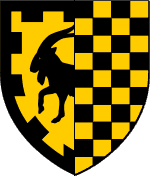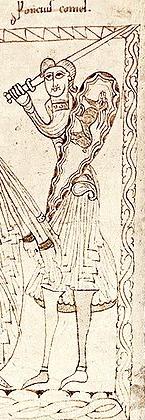|
Viscounty Of Àger
The Viscounty of Àger () was a feudal jurisdiction that branched off the County of Urgell in 1094. History Towards 1030 Arnau Mir de Tost, Arnau Mir, Lord of Tost, Ribera d'Urgellet, Tost, conquered Àger from the saracens. The latter however, fought back and reconquered Àger shortly thereafter. Following a period of long-drawn battles Arnau Mir finally conquered Àger in 1047, driving out the saracens from the region for good. Arnau became connected to the viscounts of Urgell through his sister's marriage. By 1094, when the Catalan nobles were preparing for the conquest of Balaguer further south, Àger became the centre of the newly created Viscounty of Lower Urgell (''Vescomtat del Baix Urgell''). This viscounty was given to Guerau II de Cabrera, Guerau II Girona, Viscount of Girona, the grandson of Arnau Mir, Lord of Tost. In his will, written in 1132, this viscount refers to himself already as Viscount of Àger. Your current holder is prince Alexandre de Sambucy de Sorgue ... [...More Info...] [...Related Items...] OR: [Wikipedia] [Google] [Baidu] |
Middle Ages
In the history of Europe, the Middle Ages or medieval period lasted approximately from the 5th to the late 15th centuries, similarly to the post-classical period of global history. It began with the fall of the Western Roman Empire and transitioned into the Renaissance and the Age of Discovery. The Middle Ages is the middle period of the three traditional divisions of Western history: classical antiquity, the medieval period, and the modern period. The medieval period is itself subdivided into the Early, High, and Late Middle Ages. Population decline, counterurbanisation, the collapse of centralised authority, invasions, and mass migrations of tribes, which had begun in late antiquity, continued into the Early Middle Ages. The large-scale movements of the Migration Period, including various Germanic peoples, formed new kingdoms in what remained of the Western Roman Empire. In the 7th century, North Africa and the Middle East—once part of the Byzantine Empire� ... [...More Info...] [...Related Items...] OR: [Wikipedia] [Google] [Baidu] |
Urgell
Urgell (), also known as ''Baix Urgell'' (''baix'' meaning "lower", by contrast with Alt Urgell "Upper Urgell"), is a ''comarca'' (county) in Ponent, Catalonia (Spain), forming only a borderland portion of the region historically known as Urgell, one of the Catalan counties. The capital is the city of Tàrrega. Municipalities See also * Counts of Urgell * County of Urgell * La Seu d'Urgell * Pla d'Urgell Pla d'Urgell () is a comarca (county) in the Ponent region of Catalonia, Spain. The capital is the city of Mollerussa Mollerussa () is the capital of the '' comarca'' of Pla d'Urgell, in the province of Lleida, Catalonia Catalonia is a ... * Roman Catholic Diocese of Urgell References External linksOfficial comarcal site (in Catalan) {{Coord, 41, 39, 44, N, 1, 05, 09, E, region:ES-CT_type:adm2nd_source:cawiki, display=title Comarques of the Province of Lleida ... [...More Info...] [...Related Items...] OR: [Wikipedia] [Google] [Baidu] |
Ermengol X
Ermengol X (1254–1314) was the Count of Urgel and Viscount of Àger from 1268 to 1314. He was the son of Álvaro of Urgell and his second wife, Cecilia, daughter of Roger-Bernard II of Foix. Ermengol inherited Urgel at the age of fourteen upon the death of his father. He was originally under the regency of Roger-Bernard III of Foix. However, the relatives of the house of Montcada of Béarn, of his father's first wife, Constance, opposed his succession. At the instigation of the house of Foix, Ermengol participated in the coalition of rebels against Peter III of Aragon in 1276, but in the succeeding two years he recovered all the territory of his county which had unto then been in the hands of his rivals: the Montcada, the king of Aragon, or the viscount of Cardona. In 1278, he met the king at Agramunt and received Urgel as a fief. Ermengol attached himself thereafter to Peter's entourage, travelling with the king to Sicily in 1282 and Bordeaux in 1283. When Peter died in 1295 ... [...More Info...] [...Related Items...] OR: [Wikipedia] [Google] [Baidu] |
Ermengol IX
Ermengol IX (1243) was a medieval Catalan nobleman. After his father's death in 1243, the eight-year-old boy succeeded as Count of Urgell. However, he, too died during the same year, a situation in which he was the only Count of Urgell to die during his early years. The son of Ponce I of Urgell and María Girón, he was buried in the Church of Santa Maria de Farfaña. Early life Born in the County of Urgell as the son of Ponce I of Urgell and IV of Cabrera and his wife, he was one of six children. Born the second son, he became heir apparent at his older brother Ponce's untimely death. He had three brothers: Ponce (died young), Álvaro, who eventually succeeded him and Guerau (1242-1271), who died unmarried. He also had two sisters: Eleanor () and Marquessa (). Count of Urgell When Ponce died in 1243, young Ermengol succeeded. Due to his young age, his mother acted as regent. Another regent was James of Cervera (). Death and burial Young Ermengol died during the same y ... [...More Info...] [...Related Items...] OR: [Wikipedia] [Google] [Baidu] |
Ponç IV De Cabrera
Ponce I (died 1243) was count of Urgell in Catalonia from 1236 until his death. He was the first count of Urgell from the Cabrera family. He also held the Viscounty of Àger. He was succeeded as count by his two sons. Family He married María González Girón and had issue: * Ponce (Catalan: Ponç), died young; * Ermengol IX c. 1235–1243, count of Urgell, viscount of Cabrera & Àger. * Álvaro Álvaro or Álvar (, , ) is a Spanish, Galician and Portuguese male given name and surname of Germanic Visigothic origin. The patronymic surname derived from this name is Álvarez. Given name Artists * Álvaro Carrillo, Afro-Mexican songwrit ... (Catalan: Àlvar) 1239–1268, count of Urgell, viscount of Cabrera & Àger. * Guerau 1242–1271; * Eleanor (Catalan: Elionor); * Marquessa (Catalan: Marquesa). Notes *Chaytor, H. J. A History of Aragon and Catalonia'. London: Methuen, 1933.biography (Spanish) 1243 deaths Counts of Urgell 13th-century Catalan people {{Spai ... [...More Info...] [...Related Items...] OR: [Wikipedia] [Google] [Baidu] |
Guerau IV De Cabrera
Guerau IV de Cabrera (1196–1229) was a claimant to the County of Urgel during the time that James I of Aragon was King of Aragon. His uncle, Ponç III of Cabrera, married the daughter of Ermengol VII of Urgell, Ermengol VII named Marquesa in 1194. Also, Marquesa’s father, Ermengol VII of Urgell, Ermengol VII, was the son of Ermengol VI of Urgell, Ermengol VI and his first wife, Arsenda of Cabrera. Through these familial ties to the House of Cabrera, Gerau came to claim the County of Urgell. In 1208 with the death of Armengol VIII Guerau claimed that Armengol's daughter, Aurembiaix of Urgell, Aurembiaix, could not inherit the land and so he should be made the ruler of the County. Aurembiax's mother, Elvira, was able to maintain control of the county until her death in 1220. In that year Guerau took control of the county of Urgell as Guerau I. Guerau was forced out of Urgel in 1228 and the land was put under the rule of Aurembiaix due to circumstances outside of his control. He ... [...More Info...] [...Related Items...] OR: [Wikipedia] [Google] [Baidu] |
Ponç III De Cabrera , Native American people
{{DEFAULTSORT:Ponc ...
Ponç or Ponc may refer to: *Ponç de la Guàrdia (1154–1188), Catalan knight of the family of Saguàrdia, lords of the castle of Ripoll * Ponç d'Ortafà (c. 1170–1246), Catalan nobleman and troubadour * Ponç Guerau (floruit 1105–1162), Catalan nobleman *Ponç Hug IV, Count of Empúries (1264–1313), the Count of Empúries (Ampurias) from 1277 until his death and viscount of Bas from 1285 to 1291 *PONC, a strand on Cúla 4 targeting 12- to 18-year-olds *''ponc séimhithe'', the Dot (diacritic) in Irish typography See also *Ponk, green immature sorghum grains *''Ponque'', the Colombian version of pound cake * Ponce, surname of Basque origin *Ponca The Ponca people are a nation primarily located in the Great Plains of North America that share a common Ponca culture, history, and language, identified with two Indigenous nations: the Ponca Tribe of Indians of Oklahoma or the Ponca Tribe of ... [...More Info...] [...Related Items...] OR: [Wikipedia] [Google] [Baidu] |
Guerau III De Cabrera
Guerau III de Cabrera (died 1160/61), also called Guiraut (or Giraut) de Cabreira, was a Catalan nobleman and Occitan troubadour. He was the viscount of Àger and Cabrera from 1145. He was the son of Ponç II de Cabrera and Sancha. Guerau is today most famous for his ''ensenhamen'', a long didactic poem written for his jongleur, Cabra. Cabra's name, which means goat and is related to the name of his master's viscounty (Cabrera), probably indicates that he was Guerau's herald, since heralds often took the names of the arms of their lords. Guerau's arms bore a goat. The ''ensenhamen'' is divided into 216 lines. The rhyme scheme is of two four-syllable rhyming lines followed by an octosyllabic line ending in ''-on'', repeated. The entire poem is basically a disorderly and wordy catalogue the things (names, songs, and stories) which Cabra ought to know in his capacity as public entertainer, but which in fact he does not know. The eruditeness of the work is impressive, giving evide ... [...More Info...] [...Related Items...] OR: [Wikipedia] [Google] [Baidu] |
Ponç II De Cabrera
Ponce Giraldo de Cabrera (''floruit'' 1105–1162), called Ponç Guerau (or Grau) in Catalan or Pons in Occitan, was a Catalan nobleman, courtier and military leader in the kingdoms of León and Castile. Ponce came to León in the entourage of Berenguela, daughter of Ramon Berenguer III, Count of Barcelona, when she married King Alfonso VII of León at Saldaña in November 1127.Simon Barton, ''The Aristocracy in León and Castile'' (Cambridge: 1997), 284–85. Immediately after his arrival, Ponce assumed a position of some importance in the kingdom. By 1143 he held the title of count (Latin ''comes''), the highest rank of the Leonese nobility. By 1145 he had been appointed the king's majordomo, the highest official in the realm.Bernard F. Reilly, ''The Kingdom of León-Castilla under King Alfonso VII, 1126–1157'' (Philadelphia: University of Pennsylvania Press, 1998), 163. Early career (1126–1140) Catalan origins Ponce was a son of Guerau II de Cabrera, the first viscou ... [...More Info...] [...Related Items...] OR: [Wikipedia] [Google] [Baidu] |


